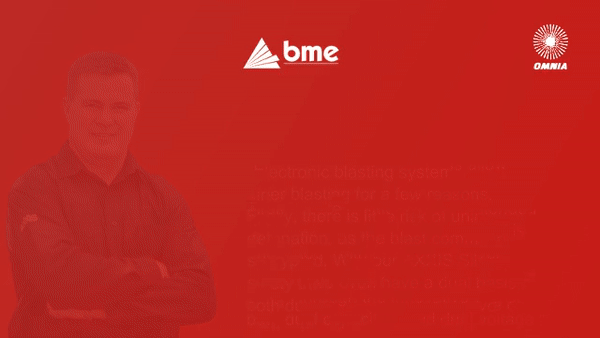Blasting is the single most critical operation affecting the entire mining or quarrying cycle. The current pain points in blasting stem from several key elements, including safety, community relations, legislation and production requirements. In a one-on-one with Quarrying Africa, Hennie du Preez, Manager for AXXIS support at BME, discusses how electronic initiation systems can address these challenges and optimise the whole mining process.
Key Takeaways:
- The current pain points in blasting stem from several key elements, including safety, community relations, legislation and production requirements.
- With the advent of electronic initiation systems, it is now possible not only to meet higher safety levels and environmental impact control, but to also gain more blast control and improve fragmentation.
- With AXXIS Silver, quarries can free themselves from the limitations of conventional pyrotechnic solutions and improve blast outcomes.
- The accuracy and reliability of electronic detonators brings more energy to the rock and delivers better fragmentation.
The increased economic and operational pressures demand that today’s mines and quarries stay ahead to remain competitive. One area where this is particularly crucial is in blasting – a critical function that greatly influences operational efficiency, costs and the success of all the other downstream processes such as load and haul, as well as crushing and screening.
Apart from regulations and production demands, some of the common pain points for quarries when it comes to blasting are ground vibrations, coupled with the risk of fly-rock, not to mention noise and dust creation.

“Electronic blasting systems allow safer blasting for a few reasons. Firstly, there is little risk of unintended detonation, as the blast command is encrypted. With our AXXIS Silver system, we even have a dual basis of safety through the innovative use of both dual capacitors and dual voltage.”
Hennie du Preez, Manager for AXXIS support at BME
With the advent of electronic initiation systems, says Du Peez, it is now possible to meet higher safety levels and environmental impact control, but to also gain more blast control and improve fragmentation, thus delivering more downstream value to the whole operation.
With the AXXIS Silver, BME’s cost-effective electronic system for operations with less demanding blasting needs, quarries can free themselves of conventional pyrotechnic solutions and improve blast outcomes.
Safety and regulations
In an environment where safety is principal, the regulator, the Department of Mineral Resources and Energy (DMRE), is pushing quarries to adopt electronic blasting systems to improve safety, a principal parameter in blasting and the mining cycle in general.
As a result, Du Preez notes that the majority of quarries in South Africa have migrated from pyrotechnic to electronic initiation systems in recent years, with very few operations still using shock tube alternatives.
“Electronic blasting systems allow safer blasting for a few reasons. Firstly, there is little risk of unintended detonation, as the blast command is encrypted. With our AXXIS Silver system, we even have a dual basis of safety through the innovative use of both dual capacitors and dual voltage.” he says. “Secondly, the blasts can be better controlled, which means less risk of fly—rock or vibration damage; this is becoming more important for quarries as urban settlements expand and encroach on quarry boundaries.”
Using its AXXIS technology, BME has executed some of the most challenging blasts, with limited ground vibrations, in recent times. For example, the company successfully blasted next to a pipeline in Vereeniging, Gauteng. where the peak particle velocity (PPV) had to be extremely low.
It is common knowledge that closer distances lead to higher PPV values, but by using the AXXIS electronic system, BME achieved a PPV of less than 50. In Midrand, the company blasted at a civil site next to a gym and office building with a minimum vibration of 5 and less. Another milestone project is the Clanwilliam Dam construction blasting where the PPV was less than 12.6.
A further safety benefit, he adds, relates to risks outside the quarry itself. While pyrotechnic detonators have been deployed for criminal purposes such as cash-in-transit heists and ATM bombings, electronic detonators are unlikely to be used in this way as they require a whole detonation system to make them work.
In addition, electronic detonators can be readily tracked from source to site, ensuring that every detonator that is manufactured can be closely monitored until it is initiated in the blasthole.
Production Demands
With all the easy rock already mined out and blasting becoming more difficult by the clay. Quarries have come to a point where mining has become even more difficult, yet equipment and energy costs keep rising, and the industry demands stringent product specifications. Du Preez says there is a better understanding that electronic blast systems take blast efficiency to a whole new level.
One of the key benefits of electronic detonators is the bottom-line value they offer to quarries. The accuracy and reliability of these detonators brings more energy to the rock and delivers better fragmentation. This in turn means a smoother process with less time spent breaking over— sized material. This improves the loading and hauling efficiency, while reducing the energy required in the crushing and screening process.
With the AXXIS Silver, says Du Preez, the accuracy of detonation delays is unmatched, and reaches 0.0025% ring accuracy for consistent quality blasting that results in optimal rock fragmentation and consistency. The programmability of 15 seconds with 1—millisecond intervals allows for blast designs to be precision-designed, resulting in better fragmentation.
“The benefits of good fragmentation are well documented,” says Du Preez. “Firstly, it eliminates the need for costly secondary blasting or mechanical breaking of oversize material. Secondly, there is a positive impact on downstream processes such as load and haul. Crusher throughput also increases due to improved overall particle size distribution. The overarching benefit from all this is reduced energy consumption in the mining value chain, which constitutes a sustainability effort achieved.”
Click here to read the original publication on pages 68 – 70 of Quarrying Africa.





